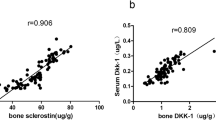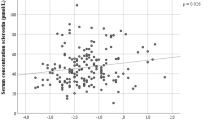Abstract
To determine the expression of signal transducer and activator of transcription 3 (STAT3) in patients with fragility fractures (FFs) and its effect on the biological function of osteoblasts. The study included 32 patients with FFs who were diagnosed and treated in the research group and 30 concurrent healthy individuals in the control group. We observed STAT3 mRNA expression in the patients with FFs and controls and altered STAT3 mRNA to detect changes in the proliferation, invasion, and apoptosis of osteoblasts. The patients with FFs presented higher serum STAT3 mRNA expression than the controls (P < 0.05). We plotted receiver operating characteristic curves based on the STAT3 mRNA expression and found that the area under the curve for STAT3 mRNA was 0.856 (P < 0.05). Transfection of STAT3 mRNA mimics resulted in increased STAT3 mRNA expression, inhibited cell proliferation as detected by an MTT assay, and increased apoptosis rate, which was determined using flow cytometry with human fetal osteoblastic cell line 1.19 cells. STAT3 mRNA expression was elevated in the serum of patients with FFs and can be used as a biomarker for the diagnosis of the disease. Regulating STAT3 mRNA can inhibit the proliferation and induce the osteoblasts apoptosis.


Similar content being viewed by others
Availability of data and materials
The data used to support the findings of this study are available from the corresponding author upon request.
References
Burge R, Dawson-Hughes B, Solomon DH, Wong JB, King A, Tosteson A (2007) Incidence and economic burden of osteoporosis-related fractures in the United States, 2005–2025. J Bone Miner Res 22:465–475. https://doi.org/10.1359/jbmr.061113
Ganju A, Khan S, Hafeez BB, Behrman SW, Yallapu MM, Chauhan SC, Jaggi M (2017) miRNA nanotherapeutics for cancer. Drug Discov Today 22:424–432. https://doi.org/10.1016/j.drudis.2016.10.014
Haentjens P, Autier P, Collins J, Velkeniers B, Vanderschueren D, Boonen S (2003) Colles fracture, spine fracture, and subsequent risk of hip fracture in men and women: a meta-analysis. J Bone Joint Surg Am 85:1936–1943. https://doi.org/10.2106/00004623-200310000-00011
Kanis JA, Cooper C, Rizzoli R, Reginster JY (2019) European guidance for the diagnosis and management of osteoporosis in postmenopausal women. Osteoporos Int 30:3–44. https://doi.org/10.1007/s00198-018-4704-5
Li J, He X, Wei W, Zhou X (2015) MicroRNA-194 promotes osteoblast differentiation via downregulating STAT1. Biochem Biophys Res Commun 460:482–488. https://doi.org/10.1016/j.bbrc.2015.03.059
Li Q et al (2016) miR-139-5p inhibits the epithelial-mesenchymal transition and enhances the chemotherapeutic sensitivity of colorectal cancer cells by downregulating BCL2. Sci Rep 6:27157. https://doi.org/10.1038/srep27157
Li JQ, Rong ZH, Chen X, Yan GY, You ZH (2017) MCMDA: Matrix completion for MiRNA-disease association prediction. Oncotarget 8:21187–21199. https://doi.org/10.18632/oncotarget.15061
Li MH, Wu ZY, Wang Y, Chen FZ, Liu Y (2019) Expression of miR-29 and STAT3 in osteosarcoma and its effect on proliferation regulation of osteosarcoma cells. Eur Rev Med Pharmacol Sci 23:7275–7282. https://doi.org/10.26355/eurrev_201909_18832
Lin C et al (2019) Circulating miR-338 cluster activities on osteoblast differentiation: potential diagnostic and therapeutic targets for postmenopausal osteoporosis. Theranostics 9:3780–3797. https://doi.org/10.7150/thno.34493
Liu K et al (2017) Silencing miR-106b accelerates osteogenesis of mesenchymal stem cells and rescues against glucocorticoid-induced osteoporosis by targeting BMP2. Bone 97:130–138. https://doi.org/10.1016/j.bone.2017.01.014
Moya L, Meijer J, Schubert S, Matin F, Batra J (2019) Assessment of miR-98-5p, miR-152-3p, miR-326 and miR-4289 expression as biomarker for prostate cancer diagnosis. Int J Mol Sci. https://doi.org/10.3390/ijms20051154
Munson JC et al (2016) Patterns of prescription drug use before and after fragility fracture. JAMA Intern Med 176:1531–1538. https://doi.org/10.1001/jamainternmed.2016.4814
Oxnard GR et al (2016) Association between plasma genotyping and outcomes of treatment with osimertinib (AZD9291) in advanced non-small-cell lung cancer. J Clin Oncol 34:3375–3382. https://doi.org/10.1200/jco.2016.66.7162
Posen J, Beaton DE, Sale J, Bogoch ER (2013) Bone mineral density testing after fragility fracture: Informative test results likely. Can Fam Physician 59:e564–e571
Rouleau S, Glouzon JS, Brumwell A, Bisaillon M, Perreault JP (2017) 3’ UTR G-quadruplexes regulate miRNA binding. RNA 23:1172–1179. https://doi.org/10.1261/rna.060962.117
Rupaimoole R, Calin GA, Lopez-Berestein G, Sood AK (2016) miRNA deregulation in cancer cells and the tumor microenvironment. Cancer Discov 6:235–246. https://doi.org/10.1158/2159-8290.Cd-15-0893
Takeda M, Okamoto I, Nakagawa K (2015) Pooled safety analysis of EGFR-TKI treatment for EGFR mutation-positive non-small cell lung cancer. Lung Cancer 88:74–79. https://doi.org/10.1016/j.lungcan.2015.01.026
Tu M, Tang J, He H, Cheng P, Chen C (2017) MiR-142-5p promotes bone repair by maintaining osteoblast activity. J Bone Miner Metab 35:255–264. https://doi.org/10.1007/s00774-016-0757-8
Varahra A, Rodrigues IB, MacDermid JC, Bryant D, Birmingham T (2018) Exercise to improve functional outcomes in persons with osteoporosis: a systematic review and meta-analysis. Osteoporos Int 29:265–286. https://doi.org/10.1007/s00198-017-4339-y
Vitsios DM, Davis MP, van Dongen S, Enright AJ (2017) Large-scale analysis of microRNA expression, epi-transcriptomic features and biogenesis. Nucleic Acids Res 45:1079–1090. https://doi.org/10.1093/nar/gkw1031
Wang H, Wei X, Wu B, Su J, Tan W, Yang K (2019) Tumor-educated platelet miR-34c-3p and miR-18a-5p as potential liquid biopsy biomarkers for nasopharyngeal carcinoma diagnosis. Cancer Manag Res 11:3351–3360. https://doi.org/10.2147/cmar.S195654
World Health Organization (1998) Guidelines for preclinical evaluation and clinical trials in osteoporosis. World Health Organization, Geneva
Yan TB, Li C, Jiao GJ, Wu WL, Liu HC (2018) TIMP-1 suppressed by miR-138 participates in endoplasmic reticulum stress-induced osteoblast apoptosis in osteoporosis. Free Radic Res 52:223–231. https://doi.org/10.1080/10715762.2017.1423070
Yang R, Tao Y, Wang C, Shuai Y, Jin L (2018) Circulating microRNA panel as a novel biomarker to diagnose bisphosphonate-related osteonecrosis of the jaw. Int J Med Sci 15:1694–1701. https://doi.org/10.7150/ijms.27593
Zhang Y et al (2017) MicroRNA-221 is involved in the regulation of osteoporosis through regulates RUNX2 protein expression and osteoblast differentiation. Am J Transl Res 9:126–135
Zhao X et al (2019) MicroRNA-495 enhances chondrocyte apoptosis, senescence and promotes the progression of osteoarthritis by targeting AKT1. Am J Transl Res 11:2232–2244
Funding
This work was supported by the project of Jiangsu Health and Family Planning Commission: Role and mechanism of STAT3 regulatory T cell pathway in fracture healing (Project No.: H2018024).
Author information
Authors and Affiliations
Contributions
GS, JL and YT conceived and designed the research and interpreted the results of experiments. GS, JL, ZW, XZ and YT performed experiments, analyzed data. GS and JL wrote the manuscript.
Corresponding author
Ethics declarations
Conflict of interest
On behalf of all authors, the corresponding author states that there is no conflict of interest.
Ethical approval
The study was approved by the Medical Ethics Committee of Jinling Hospital, Medicine College, Nanjing University.
Consent to participate
All patients and their families agreed to participate in the experiment and signed the informed consent form.
Additional information
Publisher's Note
Springer Nature remains neutral with regard to jurisdictional claims in published maps and institutional affiliations.
Rights and permissions
Springer Nature or its licensor (e.g. a society or other partner) holds exclusive rights to this article under a publishing agreement with the author(s) or other rightsholder(s); author self-archiving of the accepted manuscript version of this article is solely governed by the terms of such publishing agreement and applicable law.
About this article
Cite this article
Sun, G., Lu, J., Wu, Z. et al. STAT3 expression in patients with fragility fractures and its effect on the biological function of osteoblasts. Cell Tissue Bank 24, 515–522 (2023). https://doi.org/10.1007/s10561-022-10051-3
Received:
Accepted:
Published:
Issue Date:
DOI: https://doi.org/10.1007/s10561-022-10051-3




